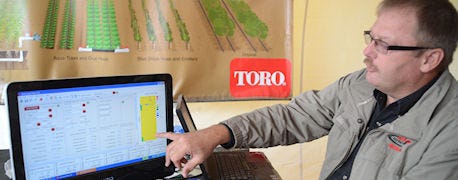
There are a number of factors -- different on every farm -- that can make or break a sub-surface drip irrigation system.
Soil types, ground slope, cropping decisions, water well location and capacity, fuel available, annual rainfall, and a host of other factors play into a successful SSD system that will provide a grower with the most water/pumping cost efficiency, says Don Masten, Ag Valley, in Edison, Neb.
Masten is in charge of the company's pump installation, SSD design and installation services, and underground pipe and wire installation. He has helped a number of growers introduce SSD into their corn and soybean fields with the help of computerized design software.

Ag Valley's Don Masten uses computerized design software to work through the problems and factors encountered on each farm as growers take on the management of sub-surface drip irrigation near in and around Edison, Neb.
Masten says one can bury drip line and hook a pump to it and water a field, but to do it efficiently --and to get the most for your water and pumping inputs -- you need to consult with SSD equipment suppliers to match your system to your individual farm and management style.
"The efficiency you get from a properly-designed system will pay off over and over as energy becomes more expensive and water becomes more scarce," he explained.
About the Author(s)
You May Also Like




